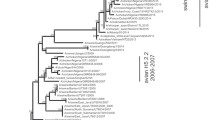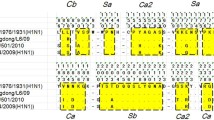Abstract
The risk of zoonotic human infection caused by European porcine influenza virus strains was estimated in German regions with a high pig density. Sera from 622 healthy volunteers were collected between April 2009 and November 2011, mainly in Westphalia and western Lower Saxony. These included 362 subjects with occupational contact to pigs and 260 blood donors without any direct exposition to pigs. Samples were analysed by the haemagglutination inhibition (HI) assay against a panel of six swine viruses of subtypes avian-like H1N1 and human-like H3N2 as well as against human H1N1 and H3N2 viruses including the pandemic H1N1 strain of 2009. Reciprocal HI titres ≥20 were quoted as seroreactive. Compared to the control group, a significantly higher proportion of subjects with direct contact to pigs exhibited seroreactivity against porcine antigens of the avian-like H1N1 (37.0 %/7.7 %), the human-like H3N2 (59.7 %/43.1 %), the pandemic H1N1 strain of 2009 (51.7 %/26.5 %) and against a historic seasonal H3N2 strain that is closely related antigenetically to currently circulating human-like H3N2 viruses of European pigs (57.5 %/36.5 %). This trend was also observed when a reciprocal HI titre ≥40 was chosen as cut-off. Particularly, in younger subjects, the differences in seroreactivity against porcine strains between the exposed and non-exposed group were significant. The data indicate a higher risk of infection in the exposed individuals.

Similar content being viewed by others
References
McCauley JW, Hongo S, Kaverin NV, Kochs G, Lamb RA, Matrosovich MN, Perez DR, Palese P, Presti RM, Rimstad E, Smith GJD (2012) Orthomyxoviridae. In: King AMQ, Adams MJ, Carstens EB, Lefkowitz EJ (eds) Virus taxonomy, ninth report of the international committee on taxonomy of viruses. Elsevier Inc., Amsterdam, pp 749–761
Lamb RA, Krug RM (2001) Orthomyxoviridae: the viruses and their replication. In: Knipe DM, Howley PM-D, Griffin DE, Lamb RA, Martin MA, Roizman B (eds) Fields virology. Lippincott Williams & Wilkins, Philadelphia, pp 1487–1531
Causey D, Edwards SV (2008) Ecology of avian influenza virus in birds. J Infect Dis 197(Suppl 1):S29–S33
Tong S, Li Y, Rivailler P, Conrardy C, Castillo DA, Chen LM, Recuenco S, Ellison JA, Davis CT, York IA, Turmelle AS, Moran D, Rogers S, Shi M, Tao Y, Weil MR, Tang K, Rowe LA, Sammons S, Xu X, Frace M, Lindblade KA, Cox NJ, Anderson LJ, Rupprecht CE, Donis RO (2012) A distinct lineage of influenza A virus from bats. Proc Natl Acad Sci USA 109:4269–4274
Palese P, Wang TT (2011) Why do influenza virus subtypes die out? A hypothesis. MBio 2(5)
Reperant LA, Kuiken T, Osterhaus AD (2012) Adaptive pathways of zoonotic influenza viruses: from exposure to establishment in humans. Vaccine 30:4419–4434
Anonymous (2013) Cumulative number of confirmed human cases for avian influenza A(H5N1) reported to WHO, 2003–2013, data in HQ as of 05 July 2013. http://www.who.int/influenza/human_animal_interface/EN_GIP_20130705CumulativeNumberH5N1cases_2.pdf. WHO
Gao R, Cao B, Hu Y, Feng Z, Wang D, Hu W, Chen J, Jie Z, Qiu H, Xu K, Xu X, Lu H, Zhu W, Gao Z, Xiang N, Shen Y, He Z, Gu Y, Zhang Z, Yang Y, Zhao X, Zhou L, Li X, Zou S, Zhang Y, Li X, Yang L, Guo J, Dong J, Li Q, Dong L, Zhu Y, Bai T, Wang S, Hao P, Yang W, Zhang Y, Han J, Yu H, Li D, Gao GF, Wu G, Wang Y, Yuan Z, Shu Y (2013) Human infection with a novel avian-origin influenza A (H7N9) virus. N Engl J Med 368(20):1888–1897
Anonymous (2013) Human infection with avian influenza A(H7N9) virus—update. http://www.who.int/csr/don/2013_08_11/en/index.html. WHO
Van Reeth K, Nicoll A (2009) A human case of swine influenza virus infection in Europe–implications for human health and research. Euro Surveill 14(7)
Myers KP, Olsen CW, Gray GC (2007) Cases of swine influenza in humans: a review of the literature. Clin Infect Dis 44:1084–1088
Olsen CW (2002) The emergence of novel swine influenza viruses in North America. Virus Res 85:199–210
Shinde V, Bridges CB, Uyeki TM, Shu B, Balish A, Xu X, Lindstrom S, Gubareva LV, Deyde V, Garten RJ, Harris M, Gerber S, Vagasky S, Smith F, Pascoe N, Martin K, Dufficy D, Ritger K, Conover C, Quinlisk P, Klimov A, Bresee JS, Finelli L (2009) Triple-reassortant swine influenza A (H1) in humans in the United States, 2005–2009. N Engl J Med 360:2616–2625
Anonymous (2013) Case count: detected U.S. human infections with H3N2v by state since August 2011; May 18, 2013. http://www.cdc.gov/flu/swineflu/h3n2v-case-count.htm. CDC
Zell R, Scholtissek C, Ludwig S (2013) Genetics, evolution, and the zoonotic capacity of European Swine influenza viruses. Curr Top Microbiol Immunol 370:29–55
Starick E, Lange E, Grund C, Grosse Beilage E, Dohring S, Maas A, Noe T, Beer M, Harder TC (2012) Reassortants of pandemic influenza A virus H1N1/2009 and endemic porcine HxN2 viruses emerge in swine populations in Germany. J Gen Virol 93:1658–1663
Howard WA, Essen SC, Strugnell BW, Russell C, Barass L, Reid SM, Brown IH (2011) Reassortant Pandemic (H1N1) 2009 virus in pigs, United Kingdom. Emerg Infect Dis 17:1049–1052
Starick E, Lange E, Fereidouni S, Bunzenthal C, Hoveler R, Kuczka A, Grosse Beilage E, Hamann HP, Klingelhofer I, Steinhauer D, Vahlenkamp T, Beer M, Harder T (2011) Reassorted pandemic (H1N1) 2009 influenza A virus discovered from pigs in Germany. J Gen Virol 92:1184–1188
Moreno A, Di Trani L, Faccini S, Vaccari G, Nigrelli D, Boniotti MB, Falcone E, Boni A, Chiapponi C, Sozzi E, Cordioli P (2011) Novel H1N2 swine influenza reassortant strain in pigs derived from the pandemic H1N1/2009 virus. Vet Microbiol 149:472–477
Claas EC, Kawaoka Y, de Jong JC, Masurel N, Webster RG (1994) Infection of children with avian-human reassortant influenza virus from pigs in Europe. Virology 204:453–457
Gregory V, Bennett M, Thomas Y, Kaiser L, Wunderli W, Matter H, Hay A, Lin YP (2003) Human infection by a swine influenza A (H1N1) virus in Switzerland. Arch Virol 148:793–802
Gregory V, Lim W, Cameron K, Bennett M, Marozin S, Klimov A, Hall H, Cox N, Hay A, Lin YP (2001) Infection of a child in Hong Kong by an influenza A H3N2 virus closely related to viruses circulating in European pigs. J Gen Virol 82:1397–1406
Rimmelzwaan GF, de Jong JC, Bestebroer TM, van Loon AM, Claas EC, Fouchier RA, Osterhaus AD (2001) Antigenic and genetic characterization of swine influenza A (H1N1) viruses isolated from pneumonia patients in The Netherlands. Virology 282:301–306
Adiego Sancho B, Omenaca Teres M, Martinez Cuenca S, Rodrigo Val P, Sanchez Villanueva P, Casas I, Pozo F, Perez Brena P (2009) Human case of swine influenza A (H1N1), Aragon, Spain. Euro Surveill 14(7)
Qi X, Cui L, Jiao Y, Pan Y, Li X, Zu R, Huo X, Wu B, Tang F, Song Y, Zhou M, Wang H, Cardona CJ, Xing Z (2013) Antigenic and genetic characterization of a European avian-like H1N1 swine influenza virus from a boy in China in 2011. Arch Virol 158(1):39–53
Robert-Koch-Institut (2011) Humane Fälle mit Infektion durch Schweineinfluenzaviren. Epidemiol Bull 39:357–359
Myers KP, Olsen CW, Setterquist SF, Capuano AW, Donham KJ, Thacker EL, Merchant JA, Gray GC (2006) Are swine workers in the United States at increased risk of infection with zoonotic influenza virus? Clin Infect Dis 42:14–20
Krumbholz A, Lange J, Durrwald R, Hoyer H, Bengsch S, Wutzler P, Zell R (2010) Prevalence of antibodies to swine influenza viruses in humans with occupational exposure to pigs, Thuringia, Germany, 2008–2009. J Med Virol 82:1617–1625
Krumbholz A, Neubert A, Girschick H, Huppertz HI, Kaiser P, Liese J, Streng A, Niehues T, Peters J, Sauerbrey A, Schroten H, Tenenbaum T, Wirth S, Sauerbrei A (2013) Prevalence of antibodies against hepatitis A virus among children and adolescents in Germany. Med Microbiol Immunol [Epub ahead of print]
Anonymous (2002) WHO Manual on animal influenza diagnosis and surveillance. http://www.who.int/vaccine_research/diseases/influenza/WHO_manual_on_animal-diagnosis_and_surveillance_2002_5.pdf. WHO
Ott U, Sauerbrei A, Lange J, Schafler A, Walther M, Wolf G, Wutzler P, Zell R, Krumbholz A (2012) Serological response to influenza A H1N1 vaccine (Pandemrix(R)) and seasonal influenza vaccine 2009/2010 in renal transplant recipients and in hemodialysis patients. Med Microbiol Immunol 201:297–302
Allwinn R, Bickel M, Lassmann C, Wicker S, Friedrichs I (2013) Trivalent influenza vaccination of healthy adults 3 years after the onset of swine-origin H1N1 pandemic: restricted immunogenicity of the new A/H1N1v constituent? Med Microbiol Immunol 202:125–130
Hobson D, Curry RL, Beare AS, Ward-Gardner A (1972) The role of serum haemagglutination-inhibiting antibody in protection against challenge infection with influenza A2 and B viruses. J Hyg 70:767–777
Hannoun C, Megas F, Piercy J (2004) Immunogenicity and protective efficacy of influenza vaccination. Virus Res 103:133–138
Hackenberg A, Arman-Kalcek G, Hiller J, Gabriel G (2013) Antibody prevalence to the 2009 pandemic influenza A (H1N1) virus in Germany: geographically variable immunity in winter 2010/2011. Med Microbiol Immunol 202:87–94
Anonymous (2012) Landwirtschaft—Viehwirtschaft; November 3, 2012. http://www.statistik-portal.de/Statistik-Portal/de_jb11_jahrtab22.asp. Statistische Ämter des Bundes und der Länder
De Marco MA, Porru S, Cordioli P, Cesana BM, Moreno A, Calzoletti L, Bonfanti L, Boni A, Di Carlo AS, Arici C, Carta A, Castrucci MR, Donatelli I, Tomao P, Peri VM, Di Trani L, Vonesch N (2013) Evidence of cross-reactive immunity to 2009 pandemic influenza A virus in workers seropositive to swine H1N1 influenza viruses circulating in Italy. PLoS ONE 8:e57576
Van Reeth K, Brown IH, Durrwald R, Foni E, Labarque G, Lenihan P, Maldonado J, Markowska-Daniel I, Pensaert M, Pospisil Z, Koch G (2008) Seroprevalence of H1N1, H3N2 and H1N2 influenza viruses in pigs in seven European countries in 2002–2003. Influenza x Respir Viruses 2:99–105
Durrwald R, Krumbholz A, Baumgarte S, Schlegel M, Vahlenkamp TW, Selbitz HJ, Wutzler P, Zell R (2010) Swine influenza A vaccines, pandemic (H1N1) 2009 virus, and cross-reactivity. Emerg Infect Dis 16:1029–1030
Gerloff NA, Kremer JR, Charpentier E, Sausy A, Olinger CM, Weicherding P, Schuh J, Van Reeth K, Muller CP (2009) Swine influenza virus antibodies in humans, western Europe. Emerg Infect Dis 17(2011):403–411
Cramer J, Mac T, Hogan B, Stauga S, Eberhardt S, Wichmann O, Mertens T, Burchard G (2012) Influenza A(H1N1)pdm09 antibodies after pandemic and trivalent seasonal influenza vaccination as well as natural infection in November 2010 in Hamburg, Germany. Euro Surveill 17(2)
Acknowledgments
The outstanding collaboration with all members of the German Red Cross Blood Donation Servicecentres in Münster and Springe is cordially acknowledged. The authors are indebted to Martina Müller for excellent technical assistance. The authors thank Professor Klaus Stark (Robert Koch Institute, Berlin) for helpful discussions and advice. This study was supported by a Grant of the Robert Koch Institute (FKZ 1362/1-981).
Conflict of interests
Some results of this study were presented at the 4th Influenza meeting of the Deutsche Vereinigung zur Bekämpfung der Viruskrankheiten e. V., 2012, on the National Symposium of Zoonoses Research, 2012 and on the 23rd meeting of the German Society for Virology, 2013. The authors declare no conflict of interests.
Author information
Authors and Affiliations
Corresponding author
Electronic supplementary material
Below is the link to the electronic supplementary material.
Rights and permissions
About this article
Cite this article
Krumbholz, A., Lange, J., Dürrwald, R. et al. Prevalence of antibodies to European porcine influenza viruses in humans living in high pig density areas of Germany. Med Microbiol Immunol 203, 13–24 (2014). https://doi.org/10.1007/s00430-013-0309-y
Received:
Accepted:
Published:
Issue Date:
DOI: https://doi.org/10.1007/s00430-013-0309-y




